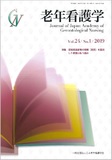Japanese
English
- 販売していません
- Abstract 文献概要
- 参考文献 Reference
抄録
本研究では過去5年間にさかのぼり,独居要介護高齢者100人の居宅介護支援者台帳と介護認定に関する書類から,要介護度改善群,入院群,入所群,在宅死群に分類し,要介護度の変化と在宅サービスの利用状況の特徴を明らかにした.その結果,対象者の在宅療養終了時の転帰は入院が45人(45%),入所が31人(31%),要介護度の改善が15人(15%),在宅死は9人(9%)であった.在宅療養終了時には,要介護度改善群に比べ入所群の者は在宅サービスの種類が有意に増え(p=.047),在宅死群の者は,医療系在宅サービスの種類が有意に増えていた(p=.036).また,要介護度改善群の者は軽度の要介護度で経過し(p<.001),入所群の者は療養開始時点から終了時点の平均要介護度は1.5(標準偏差0.7)から2.4(標準偏差1.1)に低下していた(p=.002).以上より,要介護度改善群の者は要介護度が重度に移行せず療養生活を終了する傾向があり,入所群の者は在宅療養終了時には要介護度は悪化し,在宅サービスの種類を増やす傾向が示された.また,在宅死群の者は在宅療養終了時には医療系在宅サービスの種類を増やす傾向にあることが示された.
This study examines the changes in care needs level and home care services utilization among 100 elderly persons requiring long-term care for living alone by investigating long-term care insurance documents from the past five years. The reasons for terminating home care were analyzed; the rates of elderly people who were hospitalized, institutionalized, whose care needs level was improved, and who died at home were 45%, 31%, 15%, and 9%, respectively. When home care was terminated, elderly people who were institutionalized were more likely to have used various types of home care services (p = .047), and those who died at home were more likely to have used various types of home health care services (p = .036). The care needs levels of elderly people who improved their care needs remained lower (p < .001) during the home care period and declined from a mean of 1.5 (standard deviation 0.7) to 2.4 (standard deviation 1.1) (p = .020) among those who were institutionalized. The results suggested that elderly people who improved their care needs level could maintain it during the home care period. At the end of home care, those who were institutionalized were more likely to have a lower care needs level and use various types of home care, and those who died at home were more likely to use various types of home health care.
Copyright © 2019, Japan Academy of Gerontological Nursing All rights reserved.


